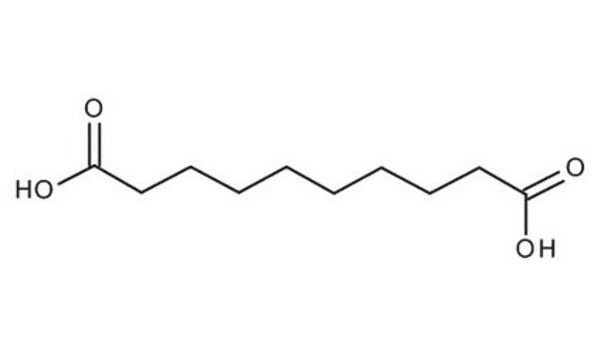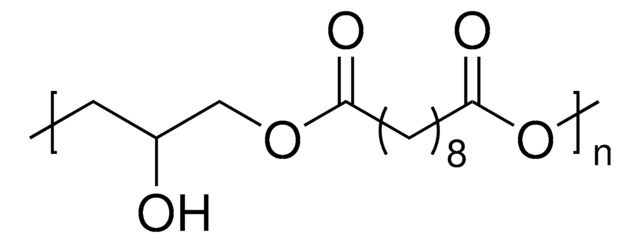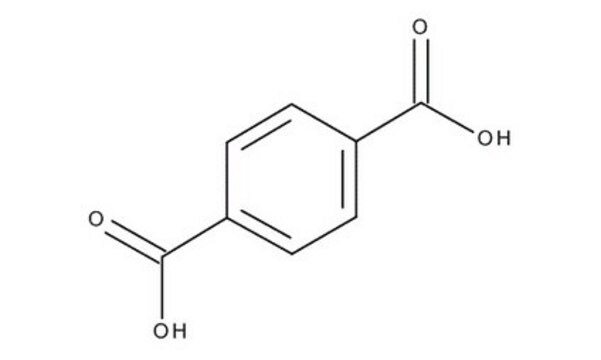84809
Sebacic acid
≥95.0% (GC)
Synonym(s):
Decanedioic acid
Sign Into View Organizational & Contract Pricing
All Photos(1)
About This Item
Linear Formula:
HO2C(CH2)8CO2H
CAS Number:
Molecular Weight:
202.25
Beilstein/REAXYS Number:
1210591
EC Number:
MDL number:
UNSPSC Code:
12352100
PubChem Substance ID:
NACRES:
NA.22
Recommended Products
vapor pressure
1 mmHg ( 183 °C)
Quality Level
assay
≥95.0% (GC)
bp
294.5 °C/100 mmHg (lit.)
mp
133-137 °C (lit.)
functional group
carboxylic acid
SMILES string
OC(=O)CCCCCCCCC(O)=O
InChI
1S/C10H18O4/c11-9(12)7-5-3-1-2-4-6-8-10(13)14/h1-8H2,(H,11,12)(H,13,14)
InChI key
CXMXRPHRNRROMY-UHFFFAOYSA-N
Looking for similar products? Visit Product Comparison Guide
Storage Class
11 - Combustible Solids
wgk_germany
WGK 1
flash_point_f
Not applicable
flash_point_c
Not applicable
ppe
Eyeshields, Gloves, type N95 (US)
Choose from one of the most recent versions:
Already Own This Product?
Find documentation for the products that you have recently purchased in the Document Library.
Customers Also Viewed
Senja K Lopac et al.
Journal of biomedical materials research. Part B, Applied biomaterials, 91(2), 938-947 (2009-07-31)
The release kinetics and stability of ovalbumin encapsulated into polyanhydride microspheres with varying chemistries were studied. Polymers based on the anhydride monomers sebacic acid (SA), 1,6-bis(p-carboxyphenoxy)hexane (CPH), and 1,8-bis (p-carboxyphenoxy)-3,6-dioxaoctane (CPTEG) were utilized. Microspheres were fabricated using two non-aqueous methods:
Christopher D Pritchard et al.
Biomaterials, 31(31), 7978-7984 (2010-07-27)
In retinal transplantation experiments it is hypothesized that remaining diseased photoreceptor cells in the host retina and inner retinal cells in transplants physically obstruct the development of graft-host neuronal contacts which are required for vision. Recently, we developed methods for
Magdalena Kwiatkowska et al.
Polymers, 12(2) (2020-02-08)
In this work the preparation of polyamide 12 (PA12) based composites reinforced with pristine and surface-modified carbon nanotubes is reported. A qualitative and quantitative evaluation of multi-walled carbon nanotube functionalization with oxygen containing reactive groups achieved by different procedures of
Hyung-seok Park et al.
Acta biomaterialia, 8(8), 2911-2918 (2012-04-24)
High molecular weight biodegradable polyesters were prepared from sebacic acid, ethylene glycol and butylene glycol through a simple non-solvent polycondensation with a low toxicity catalyst. The successful synthesis of the polyesters was confirmed by gel permeation chromatography, (1)H-nuclear magnetic resonance
Benjamin C Tang et al.
Biomaterials, 31(2), 339-344 (2009-10-03)
Drug carrier particles composed of poly(ethylene glycol)-co-poly(sebacic acid) (PEG-PSA) have been shown capable of efficient aerosolization into model lungs and the ability to rapidly penetrate human mucus. Here, we develop PEG-PSA particles (Etop/PEG-PSA) that encapsulate up to 40% etoposide by
Our team of scientists has experience in all areas of research including Life Science, Material Science, Chemical Synthesis, Chromatography, Analytical and many others.
Contact Technical Service













